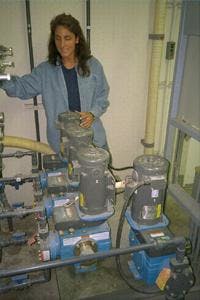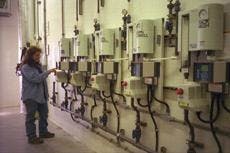By Steve Hall And Rosie Pindilli
The upgrade and expansion of the Soldier Canyon Filter plant has been an ongoing endeavor since 1989. With this rapid expansion, optimization of critical processes such as chemical feed has become a major priority for the facility. To meet present and future demands, the plant, which serves the Fort Collins, CO, area, recently upgraded its chemical feed systems to bring added capacity and flexibility while further optimizing facility performance.
The original plant was constructed in 1963 to produce 4 mgd. Improvements completed in the 1970s increased capacity to 20 mgd and another expansion in 1991 brought treatment capacity to 30 mgd. A current expansion project, scheduled for completion in 2003, will bring the plant's treatment capacity to 52 mgd. The plant's treatment processes include rapid mix, flocculation, oxidation, filtration and chlorination.
Chemical Feed
Unlike many facilities that are undergoing expansion and must replace worn out and outdated chemical feed equipment, the Soldier Canyon Filter Plant instead needed to gain expandability and increased automation as well as gain robust systems that would ensure all chemical feed operations perform at optimum levels as demand on the plant continues to increase. One example of this is the recent installation of 17 new mechanical diaphragm metering pumps.
Either aluminum chlorhydrate (ACH) or an ACH/alum (aluminum sulfate) combination is added to the raw water ahead of inline mixing. Streaming current monitors control the coagulant feed rate. ACH, the primary coagulant, is typically fed at a rate of 6-10 mg/L. Alum, used at the facility primarily for TOC removal, is typically fed at a rate of 4-8 mg/L.
It is imperative that the dispensing and metering of coagulants be accomplished with accuracy as well as with dependability, ease of use, and durability of equipment. As part of the new chemical feed systems recently added at the facility, twelve 0.5-hp Encore® 700 mechanical diaphragm metering pumps equipped with DC drives were selected for the coagulant feed system — four are used for ACH feed and four for alum feed. A third bank of four pumps serve as a backup feed system and are also used for conducting field trials of new coagulants.
The Encore 700 pumps, from USFilter's Wallace & Tiernan Products, provide a sinusoidal diaphragm stroke, evenly distributing coagulant from the day tanks to the water flow. A stroke adjustment mechanism on the pump allows for coagulant feed to be controlled by varying the stroke length or stroke frequency. The short suction and discharge porting of the pump minimizes friction losses and cavitations, providing efficient coagulant metering. A secondary diaphragm seal separates the pump head from the drive unit, eliminating the risk of cross-contaminating gearbox lubricant and process fluid. The pump's guided ball-and-seat clear PVC cartridge valves provide built-in sight flow indication.
The Soldier Canyon Filter Plant opted to outfit the pumps with field convertible pulley drives, which will allow the units to remain in uninterrupted service as plant flows and capacity increases. The pulley drive arrangement provides for an additional 4:1 rangeability on stroke frequency using a standard induction motor. In addition to coagulant feed, five .75-hp Encore 700 pumps have been added for feeding a flocculant aid to the plant's flocculation basins.
Dry Polymer
In the flocculation process, flow subjected to rapid in-line mixing enters four, serpentine flow, four-stage flocculation basins, each equipped with two 12-foot diameter mixing paddles. A combination of one, two or three basins is used, depending upon flow demands and seasonal conditions. A high molecular weight cationic polymer is added as a floc aid to strengthen the ACH/alum floc particles.
As part of the recent upgrade and expansion, the plant replaced a batch mixing system for dry polymer preparation and feed with a custom PolyBlend® DP500 automated system from USFilter's Stranco Products. With the new unit, polymer and water come together in the unit's high energy disperser, where initial wetting of the polymer occurs.
In the disperser, the polymer is subjected to relatively high shear environment. Then, the partially hydrated polymer enters a low energy mix tank – a low shear zone where it was further mixed. With this system, uniform, controlled dispersion energy at the moment of initial polymer wetting in the disperser helps to prevent the formation of agglomerations and eliminates the need to expose the polymer to extended aging time. The subsequent entry into a lower shear zone helps to prevent damage to the extending polymer molecules. From the mix tank, the polymer is sent to a holding tank and from there to the final feed skid to the point of application.
The plant's previous dry polymer preparation and feed system was a manual, batch-feed unit that blended polymer for approximately one hour before it was sent to a day tank. It was a time-consuming operation. With the new automated system, the only routine requirement by the operator is to maintain dry polymer in the unit's hopper. The switch to the automated system has reduced the total manhours required at the plant for polymer preparation and feed by more than 90 percent.
Chemical Dispersion
The plant has the option of injecting coagulants prior to jet mixers or a Water Champ® Chemical Induction Unit (CIU), supplied by USFilter's Stranco Products, installed as part of the recent changes to the facility's chemical feed operations.
The unit design includes a 5 hp chemical process duty motor mounted to the in-line unit with a vacuum body and airfoil design propeller at the other end. Chemical solution is injected into the body of the unit and is dispersed into the pipe while being simultaneously mixed by the propeller. The airfoil design of the titanium propeller rotates at 3,450 rpm, enabling the unit to achieve high energy transfer.
The high speed CIU was installed in a 24-inch influent pipe using a packing gland/knife gate valve arrangement, allowing the unit to be installed into the closed conduit to further enhance the chemical induction/mixing process. The in-line chemical inductor is positioned perpendicular to the conduit and is designed to generate high zone diffusion and a high turbulence region as chemical is simultaneously dispersed. Flows passing the mixing area make contact with this turbulence and distributed chemical, resulting in a high rapid mixing rate.
Disinfection/Chlorination
Water is pretreated using chlorine dioxide (ClO2) dosed at 0.4 to 0.8 mg/L. The plant began using ClO2 in 1994, after it began experiencing seasonal problems with dissolved manganese. In addition to manganese removal, the plant has found chlorine dioxide also provides other benefits, including assisting with coagulation, filter runtime and particle removal.
Although ClO2 is the primary oxidant, chlorine is used for final disinfection, applied at break-point chlorination to the combined effluent. As part of the upgrade and expansion of the plant's chemical feed systems, five new V10k Chlorinators from USFilter's Wallace & Tiernan Products, have been added to feed chlorine to the plant's north clearwell, south clearwell, north distribution system, as well as for chlorinating filter backwash.
A primary reason the new wall-mounted gas feeders were selected is the unit's V-Notch gas flow feature. The V-Notch orifice consists of a precision grooved plug that slides through an annular seat. Any position of the plug in the seat results in a specific orifice size and a corresponding feed rate, resulting in accurate gas flow control. As a single piece, the V-Notch orifice now performs what had required multiple parts to accomplish in the previous chlorinators used at the plant, resulting in easier maintenance and less parts inventory.
The V10k gas feed system operates under a vacuum that is produced at the injector and transmitted through the control unit to the vacuum regulating valve located at the gas supply. Gas then enters the vacuum regulating valve and moves toward the flow control components under vacuum. Gas next passes through the unit's rotameter, where flow rate is measured, and the V-Notch orifice, where feed rate is controlled by an automatic positioner.
Direct cylinder mounting puts the vacuum-regulating valve right at the source, reducing gas pressure to vacuum immediately. The unit's rotameters are mounted remotely, next to process control units (PIUs) that provide automatic process control. A built-in automatic switchover system on the chlorinators eliminates the need for external switching devices. The non-isolating feature allows cylinders to be emptied thoroughly, for complete gas consumption.
At the injector, the metered gas is dissolved in the water stream. The operating range of free chlorine residual leaving the plant is 1.0 to 1.4 mg/L. Dosage is dependent upon the flowrates to the three water systems supplied and is adjusted as necessary.
About the Authors: Steve Hall is Maintenance Supervisor and Rosie Pindilli is Class A Operator at the Soldier Canyon Filter Plant.





